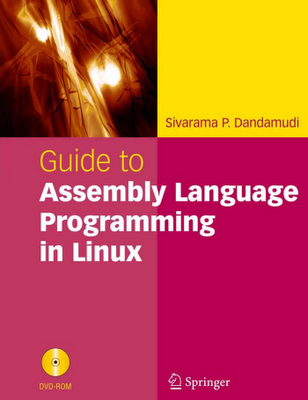
Sivarama P. Dandamudi
Contents
Preface vii
PART I Overview 1
1 Assembly Language 3
Introduction 3
What Is Assembly Language? 5
Advantages of High-Level Languages 6
Why Program in Assembly Language? 7
Typical Applications 8
Summary 8
PART II Computer Organization 9
2 Digital Logic Circuits 11
Introduction 11
Simple Logic Gates 13
Logic Functions 15
Deriving Logical Expressions 17
Simplifying Logical Expressions 18
Combinational Circuits 23
Adders 26
Programmable Logic Devices 29
Arithmetic and Logic Units 32
Sequential Circuits 35
Latches 37
Flip-Flops 39
Summary 43
3 Memory Organization 45
Introduction 45
Basic Memory Operations 46
Types of Memory 48
Building a Memory Block 50
Building Larger Memories 52
Mapping Memory 56
Storing Multibyte Data 58
Alignment of Data 59
Summary 60
4 The IA-32 Architecture 61
Introduction 61
Processor Execution Cycle 63
Processor Registers 63
Protected Mode Memory Architecture 67
Real Mode Memory Architecture 72
Mixed-Mode Operation 74
Which Segment Register to Use 75
Input/Output 76
Summary 78
PART III Linux 79
5 Installing Linux 81
Introduction 81
Partitioning Your Hard Disk 82
Installing Fedora Core Linux 92
Installing and Removing Software Packages 107
Mounting Windows File System 110
Summary 112
Getting Help 114
6 Using Linux 115
Introduction 115
Setting User Preferences 117
System Settings 123
Working with the GNOME Desktop 126
Command Terminal 132
Getting Help 134
Some General-Purpose Commands 135
File System 139
Access Permissions 141
Redirection 145
Pipes 146
Editing Files with Vim 147
Summary 149
PART IV NASM 151
7 Installing and Using NASM 153
Introduction 153
Installing NASM 154
Generating the Executable File 154
Assembly Language Template 155
Input/Output Routines 156
An Example Program 159
Assembling and Linking 160
Summary 166
Web Resources 166
8 Debugging Assembly Language Programs 167
Strategies to Debug Assembly Language Programs 167
Preparing Your Program 169
GNU Debugger 170
Data Display Debugger 179
Summary 184
PART V Assembly Language 185
9 A First Look at Assembly Language 187
Introduction 187
Data Allocation 188
Where Are the Operands 193
Overview of Assembly Language Instructions 196
Our First Program 205
Illustrative Examples 206
Summary 209
10 More on Assembly Language 211
Introduction 211
Data Exchange and Translate Instructions 212
Shift and Rotate Instructions 213
Defining Constants 217
Macros 218
Our First Program 221
Illustrative Examples 223
When to Use the XLAT Instruction 227
Summary 229
11 Writing Procedures 231
Introduction 231
What Is a Stack? 233
Implementation of the Stack 234
Stack Operations 236
Uses of the Stack 238
Procedure Instructions 239
Our First Program 241
Parameter Passing 242
Illustrative Examples 248
Summary 252
12 More on Procedures 255
Introduction 255
Local Variables 256
Our First Program 257
Multiple Source Program Modules 260
Illustrative Examples 261
Procedures with Variable Number of Parameters 268
Summary 272
13 Addressing Modes 273
Introduction 273
Memory Addressing Modes 274
Arrays 278
Our First Program 281
Illustrative Examples 282
Summary 289
14 Arithmeticlnstructions 291
Introduction 291
Status Flags 292
Arithmetic Instructions 302
Our First Program 309
Illustrative Examples 310
Summary 316
15 Conditional Execution 317
Introduction 317
Unconditional Jump 318
Compare Instruction 321
Conditional Jumps 322
Looping Instructions 327
Our First Program 328
Illustrative Examples 330
Indirect Jumps 335
Summary 339
16 Logical and Bit Operations 341
Introduction 341
Logical Instructions 342
Shift Instructions 347
Rotate Instructions 353
Bit Instructions 354
Our First Program 355
Illustrative Examples 357
Summary 360
PART VI Advanced Assembly Language 361
17 String Processing 363
String Representation 363
String Instructions 364
Our First Program 372
Illustrative Examples 373
Testing String Procedures 376
Summary 378
18 ASCII and BCD Arithmetic 379
Introduction 379
Processing in ASCII Representation 381
Our First Program 384
Processing Packed BCD Numbers 385
Illustrative Example 387
Decimal Versus Binary Arithmetic 389
Summary 390
19 Recursion 391
Introduction 391
Our First Program 392
Illustrative Examples 394
Recursion Versus Iteration 400
Summary 401
20 Protected-Mode Interrupt Processing 403
Introduction 403
A Taxonomy of Interrupts 404
Interrupt Processing in the Protected Mode 405
Exceptions 408
Software Interrupts 410
File I/O 411
Our First Program 415
Illustrative Examples 415
Hardware Interrupts 418
Direct Control of I/O Devices 419
Summary 420
21 High-Level Language Interface 423
Introduction 423
Calling Assembly Procedures from C 424
Our First Program 427
Illustrative Examples 428
Calling C Functions from Assembly . 432
Inline Assembly 434
Summary 441
22 Floating-Point Operations 443
Introduction 443
Floating-Point Unit Organization 444
Floating-Point Instructions 447
Our First Program 453
Illustrative Examples 455
Summary 458
APPENDICES 459
A Number Systems 461
Positional Number Systems 461
Conversion to Decimal 463
Conversion from Decimal 463
Binary/Octal/Hexadecimal Conversion 464
Unsigned Integers 466
Signed Integers 466
Floating-Point Representation 469
Summary 471
B Character Representation 473
Character Representation 473
ASCII Character Set 474
C Programming Exercises 477
D IA-32 Instruction Set 485
Instruction Format 485
Selected Instructions 487
E Glossary 517
Index 527
Assembly language - Wikipedia, the free encyclopedia
Introduction to Assembly Language - Swanson Technologies
Other Programming Language Books
Other Linux Books
Download
No comments:
Post a Comment